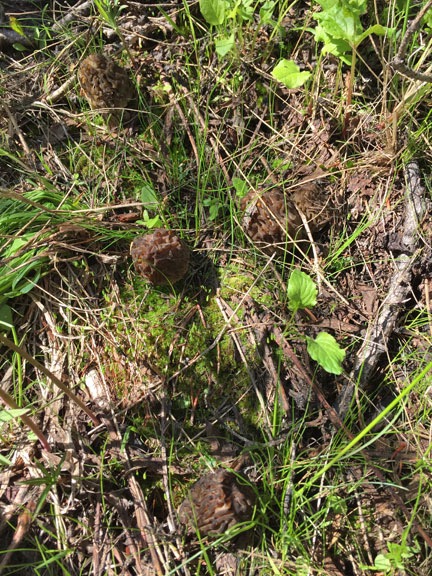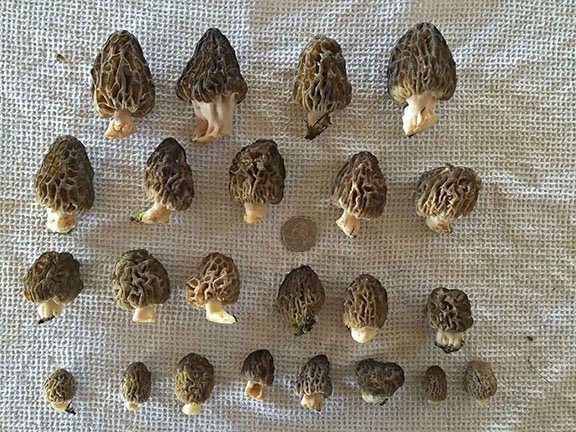I find and bag my first morel mushrooms.
Science Friday, an NPR radio show (also available as a podcast), did a show last Friday about mushroom hunting. It got me interested in mushrooms all over again.
Last October, I attended a weekend-long seminar at the North Cascades Environmental Learning Center about mushrooms. We learned about mushrooms, hunted for mushrooms, identified mushrooms, and ate mushrooms. It was a fun weekend.
About a week later, I went mushroom hunting in the Leavenworth area with one of the other seminar attendees. We didn’t do too well, but didn’t come back empty handed, either: two chanterelles, some oyster mushrooms, and something else I can’t remember. I took home the chanterelles; my companion took the rest. I returned to the area several times since then but haven’t had any success.
I’d pretty much given up on doing any serious mushroom hunting.
And then Science Friday did their story, “Mushrooms: On the Hunt for Edibles.” And I started thinking about foraging for mushrooms all over again. After all, it was the right season for them and I knew places where the conditions might be right. So I emailed my hiking buddy Susan, who also has some mushroom foraging experience, and asked her if she was interested. Of course she was! We went out around 9 AM Monday morning.
We took the Jeep up into the mountains. That’s about as specific as I’ll get for the location. As any serious mushroom hunter will tell you, locations are never divulged. Morel mushroom hunting is serious business in Washington state; hordes of hunters cross the Cascades every weekend this time of year. Some are commercial hunters; Susan says morels are worth about $30/pound. Others are hobbyists like us who use a mushroom hunt as an excuse to get outdoors and walk around in the woods.
Although we were unable to take the Jeep as far as I’d hoped, we parked at a familiar parking area, grabbed our bags, and headed into the woods. Penny ran ahead. For the next three hours, we wandered around the underbrush on either side of trails or roads, looking for just the right environmental conditions.
Trouble was, I didn’t know the right environmental conditions. I’d never hunted for morels. The only thing I’d every heard was that they grew in areas damaged by forest fires. The Science Friday story said they grew under oak and apple trees, but we don’t have oak trees here and there aren’t any apple trees other than in orchards.
After wandering around the woods off to one side of the road, Susan climbed back down to the road. “I think there’s an easier way down over here,” she called back from up ahead.

From my first find. Aren’t they gorgeous?

Can you see all five mushrooms here? Hint: two of them are together.

Here’s a closeup of one of the last morels I found. As you might imagine, from a distance, pinecones look similar.
I made my way through the underbrush. I was about halfway down the steep slope when I looked down and saw it: a very large morel mushroom. Within seconds, I’d seen three more.
They were beautiful — I mean, really beautiful. Perfectly shaped, popping up through the dirt looking clean and brown and exactly the way a morel should. I took photos. I marked GPS coordinates on my phone. And then I cut them and put them into my canvas bag.
Susan found the next batch not far away and packed them away in a paper bag she’d brought for the purpose.
We talked about the conditions they were growing in. Plants growing nearby. Moistness. Amount of sunlight. We found things in common between the two patches. We began getting a real idea of what to look for.
We continued wandering around, on and off the road, for the next two hours. We took turns finding mushrooms. At one point, Susan found a huge one about three inches from my foot and I spotted a smaller one nearby. At another point, I found five of them within a square foot of space. Much later, the two of us, working within 15 feet of each other, found several patches of them.
Now I don’t want you to think that the mushrooms were all over the place. Well, mushrooms were all over the place — mostly shiny brown round ones — but the morels were elusive. One of us would find a patch and then twenty minutes might go by before the other found a patch. We were out there for three hours and we each brought back maybe enough for a meal. I weighed mine when I got home: 9 ounces.
It was fun and, because we weren’t getting skunked, it never got frustrating.
It was nearly 1 PM when we called it quits. We’d only walked a little more than a mile according to my GPS tracker.
I drove us back to Susan’s place and took a quick tour of her backyard rose bushes and gardens. We talked about the mushrooms we’d found and how we each planned to double-check that we’d found morels and not false morels, which were not recommended for consumption. Then I headed home.
Later, I laid out the mushrooms I’d brought home to take a photo. I also weighted them on my postal scale: 9 ounces even. Good thing we weren’t hunting mushrooms for a living.

Not bad for a first time out, eh?
Dinner tonight or tomorrow: Pizza with Ramps, Morels, and Eggs. I might also try one of the recipes I found for fried morels.
And since mushrooms grow so quickly, there’s a pretty good chance there will be more to pick later this week in the same places we found them today. I’m game for another outing on Friday. I hope Susan is, too.
Discover more from An Eclectic Mind
Subscribe to get the latest posts sent to your email.

You did well indeed.
My standard small back-pack guide-book is Richard Mabey’s ‘Food for Free’. He rates the Morel (page 189) highly and claims they are associated with sandy soils, broad leaved trees such as ash and elm and old orchards. Look for them from March to May, he says.
His book is aimed at European readers but it seems to have wider relevance.
He offers an 18th century recipe:-
‘Fricassy of Morelles’.
Cleanse the sand with washing and brown a piece of
butter gold colour. Toss them up and their liquor will stove (cook) them. Season with pepper, salt and nutmeg, and an onion, and minced parsley.
Toss them up a Fricassy with egg yolk and white wine, and a little cream, and thick butter, and so serve them; and you may garnish with Lemon.
(Presumably people of the 18th century did not worry about cholesterol)
Tastes good…
That sounds yummy. I’ve had them two ways so far. The better of the two was dusted in flour and gently fried in butter.
IF I find any here in the Upper Peninsula of MI this year, I plan on trying to “seed” my yard with spawn and harvest right from my back yard. There are several videos on youtube about it. Looks pretty easy.
I was actually thinking of something like that, too — although there’s no place suitable in my yard yet. Maybe when my tiny orchard matures. Good luck and let us know how it goes!
I was browsing Mario Batali today. Morels: sauté in butter & extra virgin olive oil. Add minced shallots & fresh thyme. Sounds quick and not too messy. Worth a go?
Sounds yummy. I did a morel & leek pizza today that was good, too. Best of all, it’s making my home smell too good to leave.